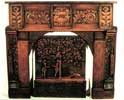
 |

Download a .pdf for a printout identifying design elements (html version) of this piece.
Aesthetics
Aesthetics
is the study of beauty and art. Aesthetic style started in England with
a group of artists and writers who reacted against the large, fancy, overly
decorated objects being made in the mid-nineteenth century. Artists started
workshops where craftspeople could make pottery, furniture, textiles, and
other products by hand.
Design
Inspiration
For design
inspiration they turned to the Medieval
Age. They chose motifs of natural forms like plants to decorate
their products. Many of the flowers were also symbols from the stories
of the Middle Ages, Greek or Roman times, or from the Bible. Aesthetic
furniture had relief
carving, usually of flowers, leaves, and vines. Compared to
the Revival styles, the Aesthetic style was plain.
One
writer of the time, Lewis F. Day, was a great supporter of exploring new
kinds of plant ornament. He wrote the textbooks The Anatomy of Pattern
and The Planning of Ornament (1887), and Nature in Ornament
(1896), which explained how to draw plant ornament from historical sources.
These and other books inspired pattern books for woodcarvers, who traced
or enlarged the line drawings by hand, drew them on sections of furniture,
and carved them by hand.
|
|
Copyright © 2000 Illinois State Museum Society